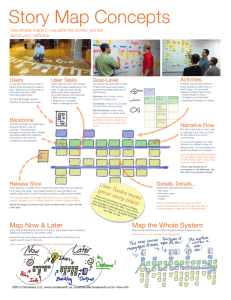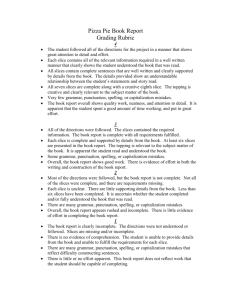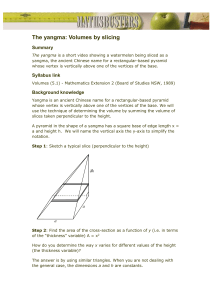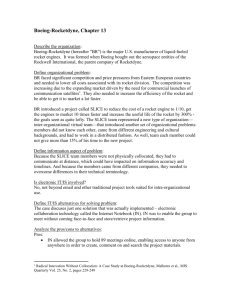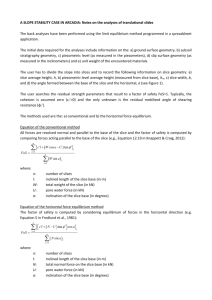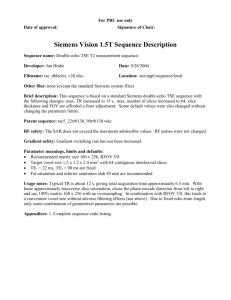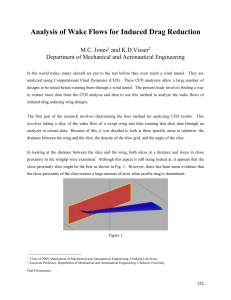TECHNICAL REPORT
advertisement
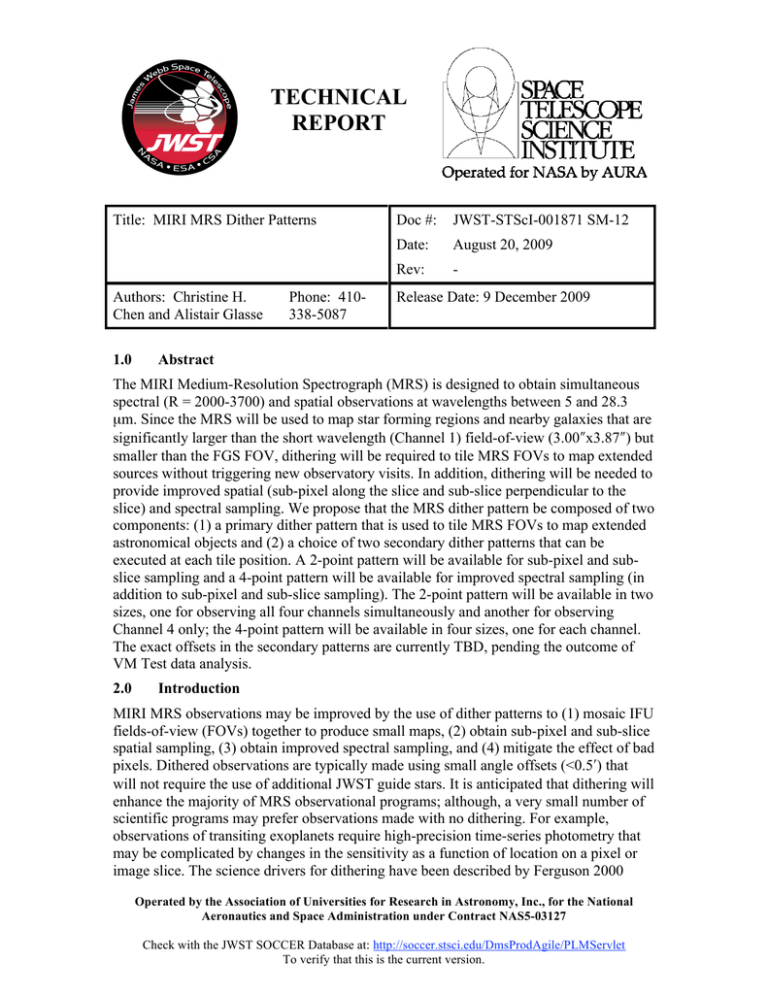
TECHNICAL REPORT Title: MIRI MRS Dither Patterns Authors: Christine H. Chen and Alistair Glasse 1.0 Phone: 410338-5087 Doc #: JWST-STScI-001871 SM-12 Date: August 20, 2009 Rev: - Release Date: 9 December 2009 Abstract The MIRI Medium-Resolution Spectrograph (MRS) is designed to obtain simultaneous spectral (R = 2000-3700) and spatial observations at wavelengths between 5 and 28.3 µm. Since the MRS will be used to map star forming regions and nearby galaxies that are significantly larger than the short wavelength (Channel 1) field-of-view (3.00″x3.87″) but smaller than the FGS FOV, dithering will be required to tile MRS FOVs to map extended sources without triggering new observatory visits. In addition, dithering will be needed to provide improved spatial (sub-pixel along the slice and sub-slice perpendicular to the slice) and spectral sampling. We propose that the MRS dither pattern be composed of two components: (1) a primary dither pattern that is used to tile MRS FOVs to map extended astronomical objects and (2) a choice of two secondary dither patterns that can be executed at each tile position. A 2-point pattern will be available for sub-pixel and subslice sampling and a 4-point pattern will be available for improved spectral sampling (in addition to sub-pixel and sub-slice sampling). The 2-point pattern will be available in two sizes, one for observing all four channels simultaneously and another for observing Channel 4 only; the 4-point pattern will be available in four sizes, one for each channel. The exact offsets in the secondary patterns are currently TBD, pending the outcome of VM Test data analysis. 2.0 Introduction MIRI MRS observations may be improved by the use of dither patterns to (1) mosaic IFU fields-of-view (FOVs) together to produce small maps, (2) obtain sub-pixel and sub-slice spatial sampling, (3) obtain improved spectral sampling, and (4) mitigate the effect of bad pixels. Dithered observations are typically made using small angle offsets (<0.5′) that will not require the use of additional JWST guide stars. It is anticipated that dithering will enhance the majority of MRS observational programs; although, a very small number of scientific programs may prefer observations made with no dithering. For example, observations of transiting exoplanets require high-precision time-series photometry that may be complicated by changes in the sensitivity as a function of location on a pixel or image slice. The science drivers for dithering have been described by Ferguson 2000 Operated by the Association of Universities for Research in Astronomy, Inc., for the National Aeronautics and Space Administration under Contract NAS5-03127 Check with the JWST SOCCER Database at: http://soccer.stsci.edu/DmsProdAgile/PLMServlet To verify that this is the current version. JWST-STScI-001871 SM-12 (STScI-NGST-R-0002A); preliminary constraints on dither patterns have been discussed in Koekemoer 2005 (JWST-STScI-000647). In this memo, we describe (1) the implementation of tiling for extended sources, identical to that currently proposed for the NIRSpec IFU (Tumlinson 2009) that also possesses a small FOV (3″x3″), (2) the 2-point dither pattern that can be used to provide improve sub-pixel and sub-slice sampling, and (3) the results from Zeemax models that have been used to design a preliminary dither pattern to provide improved spatial and spectral sampling. 3.0 MRS Design Overview The MRS will obtain simultaneous spectral (R = 2000-3700) and spatial observations over a small FOV at wavelengths between 5 and 28.3 µm. The instrument is composed of a set of Pre-optics that divide the incident light into 4 paths using three sets of dichroic filters on two dichroic/grating wheels (DGAs). These light paths are sent to 4 separate IFUs, or channels, that disperse the light and therefore provide simultaneous spatial and spectral data (see Figure 1 and Table 1). Each channel possesses a unique FOV, number of images slices, plate scale, and slice width. Although the FOVs for the individual channels may not be centered on the same position (as depicted in Figure 1), the Channel 1-3 FOVs are required to overlap by 3.5″x3.5″ and to be located within the Channel 4 FOV. Each channel possesses 3 grating positions: Short, Medium, and Long. Observers requesting observations with the MRS will select the grating positions required for their proposal. The MRS can obtain data with each of the channels simultaneously. For example, an observer may obtain data with all of the short wavelength sub-bands (Channel 1-Short, 2-Short, 3-Short, and 4-Short) simultaneously. An observer must specify data acquisition in all three sub-bands (short, medium, and long) to obtain spectra over the full wavelength range of the MRS. Since targets will be observed with all 4 channels simultaneously, some dither patterns should be optimized to provide improved sub-pixel and sub-slice sampling for all 4 channels simultaneously. Table 1 MIRI Integral Field Spectroscopy Parameters IFU Wavelength Pixel Size Slice Width FOV Resolving (µm) (arcsec) (arcsec) (arcsec2) Power 1-Short 4.87-5.82 0.196 0.176 3.00×3.87 2450-3710 1-Medium 5.62-6.73 1-Long 6.49-7.76 2-Short 7.45-8.90 3.50×4.42 2480-3690 2-Medium 8.61-10.28 2-Long 9.94-11.87 3-Short 11.47-13.67 5.20×6.19 2400-3600 3-Medium 13.25-15.80 3-Long 15.30-18.24 (22 slices) 0.196 0.277 (16 slices) 0.245 0.387 (16 slices) Check with the JWST SOCCER Database at: http://soccer.stsci.edu/DmsProdAgile/PLMServlet To verify that this is the current version. -2- JWST-STScI-001871 SM-12 IFU Wavelength Pixel Size Slice Width FOV Resolving (µm) (arcsec) (arcsec) (arcsec2) Power 4-Short 17.54-21.10 0.273 0.645 6.70×7.73 2000-2400 4-Medium 20.44-24.72 4-Long 23.84-28.82 (12 slices) Figure 1 The fields of view for the MIRI MRS. The fields of view increase in size with increasing wavelength band as shown in the legend. The slice width for the shortest wavelength channel (Channel 1) was chosen to match the PSF FWHM at the blue end of the wavelength interval (5.0 µm). The widths of the slices for Channels 2, 3, and 4 were designed to be factors of 11/7, 11/5, and 11/3 times wider than that of Channel 1, similar to the PSF FWHM at the shortest wavelength in each channel but primarily designed to provide optimal spatial sampling using a 2-point dither pattern (Glasse 2003). Since all four channels will be imaged simultaneously, one telescope offset that produces an integer plus one-half slice width dither for each of the Check with the JWST SOCCER Database at: http://soccer.stsci.edu/DmsProdAgile/PLMServlet To verify that this is the current version. -3- JWST-STScI-001871 SM-12 four channels is necessary to provide simultaneous sub-slice sampling. The pre-defined relationship between the slice widths allows a single telescope offset in the direction perpendicular to the slice to provide improved sub-slice sampling. In this case, one telescope offset corresponds to Ni+1/2 slice widths for each of the four channels, i, where Ni is the number of slice widths. A telescope offset, Xtel, will produce a Ni+1/2 slice offset if 1 ai N i + = X tel 2 where ai is the width for slice i. By construction, Xtel = 0.97″ provides a N1 = 5.5 slice dither in Channel 1, a N2= 3.5 slice dither in Channel 2, a N3 = 2.5 slice dither in Channel 3, and a N4 = 1.5 slice dither € in Channel 4. Within an IFU or MRS channel, the spectrum from each slice is mapped to a dedicated detector area. The slices are laid out so that slices that adjoin each other in the entrance aperture are not adjacent on the detector. For example, the layout for the Channel 1 slices on the SCA rotated by 90° (so that dispersion direction is along the xaxis rather than the y-axis) is shown in Figure 2. Dithering a source 0.97″ (5.5 slice widths in Channel 1) in the direction perpendicular to the slices will move a target from the Slice 2 area, near the edge of the detector, to the Slice 7 area, in the middle of the detector. Even modest dithering naturally places the target on different areas of the detector, mitigating the effects of bad pixels. Figure 2 The spectral and spatial layout for MRS Channel 1, rotated 90° so that the dispersion direction is along the x-axis. The slice number for each order is listed on the right and the pixel number is indicated on the left. Check with the JWST SOCCER Database at: http://soccer.stsci.edu/DmsProdAgile/PLMServlet To verify that this is the current version. -4- JWST-STScI-001871 SM-12 4.0 4.1 Proposed Dither Patterns The Primary Pattern: Mosaic Tiling of Extended Objects The FOVs for the IFU channels are small compared with both the angular size of astronomical targets that will be mapped and the FGS FOV. Channels 1, 2, 3, and 4 have FOVs of 3.00″x3.87″, 3.50″x4.42″, 5.20″x6.19″, and 6.70″x7.73″, respectively. Maps <40″-50″ are sufficiently small that they are unlikely to trigger new observatory visits (Nelan 2009). Therefore, construction of small maps of extended astronomical targets should be executed as dithers to mitigate the observatory overheads associated with new visits. We propose that the primary MRS dither pattern be a customizable grid of MRS FOVs, similar to that proposed for the NIRSpec IFU that also possesses from a small FOV. Using the MIRI APT mosaic tool, an observer is able currently to construct a mosaic of MIRI images by defining a map using its central position, the number of FOV row and column tiles, the degree of overlap between adjacent rows and columns, the amount of skew in both directions, and the orientation of the map (see Figure 3). Figure 3 Screen capture from the APT MIRI mosaic tool, illustrating proposed tiling of MRS FOVs. We propose that the primary dither pattern for the MRS should be tiling of the MRS FOVs using the same specifications as mosaicking for MIRI imaging. Since all four channels will be observed simultaneously, the observer should be allowed to specify and visualize the tiling using any of the channel FOVs. Some observers may require data in all four channels to complete their proposed science projects while others may choose to obtain a sparser map if their science only requires the longest wavelength data. The size of the mini-grid should be specified in the directions perpendicular and parallel to the slice direction (in addition to the number of tiles in a row and column) so that an observer can better visualize how the data will be obtained. To maximize the dichroic wheel lifetime, we anticipate that the full pattern will be executed using a single sub-band setting, followed by a dichroic change and re-execution of the map using a different subband setting if desired. Check with the JWST SOCCER Database at: http://soccer.stsci.edu/DmsProdAgile/PLMServlet To verify that this is the current version. -5- JWST-STScI-001871 SM-12 Some science programs may require MRS observations of large contiguous areas of the sky, significantly bigger than the FGS FOV. In these cases, multiple guide stars may be needed, suggesting that the observation must be broken into multiple visits. Tumlinson (2009) has pointed out that a mosaic tool within APT could be constructed ideally to break such large observations into visits, to make packaging of the observations transparent to the observer. However, this approach is currently too complex for APT, suggesting that the burden of breaking up large mosaicks of the sky will fall on the observer. 4.2 Secondary Patterns 4.2.1 Spatial Sub-Sampling: A 2-Point Pattern Unlike the Imager, the MRS is spatially under-sampled for approximately half of its wavelength range; therefore, sub-pixel sampling will be useful for the majority of the IFU channels. Channels 1, 2, 3, and 4 are critically sampled at 12.5 µm, 12.5 µm, 15.6 µm, and 17.4 µm, respectively, suggesting that Channels 1 and 2 are spatially under-sampled over their entire wavelength range, Channel 3 is under-sampled for the majority of its wavelength range, and Channel 4 is slightly over-sampled. Channels 1, 2, and 3 possess the largest need for sub-pixel sampling in descending order. For each tile position, an observer will have the ability to request a dither pattern that is designed to provide optimized sub-pixel and sub-slice sampling for all of the IFU channels simultaneously. The simplest dither pattern one could construct to provide subsampling in both the direction parallel (sub-pixel) and perpendicular to the slice (subslice) is a 2-point pattern that dithers an integer plus one-half resolution elements in both directions. The MRS was designed such that a 0.97″ step perpendicular to the slice direction would produce sub-slice sampling for all four channels simultaneously; therefore, a 2-point pattern should include a 0.97″ dither along the x-axis (perpendicular to the slices). One can estimate the telescope offset along the y-axis required to provide subpixel sampling for multiple channels simultaneously (similar to the telescope offset made to provide sub-slice imaging for all four channels simultaneously). A telescope offset, Ytel, will produce a Mi+1/2 pixel offset if 1 bi M i + = Ytel 2 where bi is the plate scale for Channel i. Even though Channels 1 and 2 possess the same plate scale, no telescope offset, Ytel, exists that will provide sub-pixel sampling for all of the channels simultaneously. € Unfortunately, no telescope offset exists that will provide sub-pixel sampling for Channels 1, 2, and 3 simultaneously because of the size ratio of the Channel 1 and 2:Channel 3 pixels. However, one can estimate the offset necessary to provide ½ pixel sub-sampling for Channels 1, 2, and 4 simultaneously. A choice of Ytel = 2.05″ provides a M1,2 = 10.5 pixel dither in Channels 1 and 2, and a M4 = 7.5 pixel dither in Channel 4. Therefore, we suggest that observers wishing to obtain better spatially sampled data use a 2-point dither with an offset of 0.97″ perpendicular to the images slices and 2.05″ parallel to the image slices as shown in Figure 4. Check with the JWST SOCCER Database at: http://soccer.stsci.edu/DmsProdAgile/PLMServlet To verify that this is the current version. -6- JWST-STScI-001871 SM-12 Figure 4 The proposed all channel 2-point dither pattern overlaid on the Channels 1 and 4 FOVs. The two positions are offset by Ni+1/2 slices in the direction perpendicular to the slices and by Mi+1/2 pixels in the direction parallel to the slices. Table 2 Proposed 2-Point Dither Pattern for All MRS Channel Observations Position 1 2 X Offset 0.0″ 0.97″ Y Offset 0.0″ 2.05″ Since the PSF size and the FOV for Channel 4 (0.68″, 6.70″×7.73″) are significantly larger than Channel 1 (0.19″, 3.00″×3.87″), an additional dither pattern with a larger offset is necessary for observers who request observations in Channel 4 only. In this case, we propose to scale up the all-channel dither pattern because the all-channel pattern is optimized to accommodate all four channels (including Channel 1 with a significantly smaller 3.7”x3.7” FOV). The larger chop-throw may help remove lowfrequency background generated by the changing thermal emission from the telescope. We scale up the all channel 2-point pattern to estimate the Channel 4 only 2-point pattern, assuming that the all channel pattern is optimized for Channel 1, the Channel 4 only pattern size should scale with FOV size, and the Channel 4 only dither pattern should provide sub-pixel and sub-slice sampling. We propose that telescope offsets Xtel = 2.26″, corresponding to a 3.5 slice dither in the direction perpendicular to the slices, and Ytel = 4.78″, corresponding to 17.5 pixel dither in the direction parallel to the slices. Observers will select which 2-point dither pattern they would like to use depending on their science goals. Check with the JWST SOCCER Database at: http://soccer.stsci.edu/DmsProdAgile/PLMServlet To verify that this is the current version. -7- JWST-STScI-001871 SM-12 Table 3 Proposed 2-Point Dither Pattern for Channel 4 Only Observations Position 1 2 4.2.2 X Offset 0.0″ 2.26″ Y Offset 0.0″ 4.78″ Spatial and Spectral Sub-Sampling: A 4-Point Pattern During the JWST mission, the MRS will observe targets that are spatially and spectrally unresolved. Zemax modeling predicts that the FWHM of unresolved spectral lines will be narrower than 2 pixels. In Channels 1, 2, and 3, unresolved lines of point and extended sources are expected to have FWHM of ~0.9 pixels and ~1.4 pixels, respectively (Glasse & Wells 2006). During the majority of observations, the line center will fall between two pixel centers, making it possible to determine the line center with better than 1 pixel accuracy. However, during a non-trivial number of observations (20% statistically), the line FWHM will overlap with a single pixel to first approximation. In these cases, subpixel sampling in the spectral direction is necessary to determine the line center with better accuracy (Brandl 2006). For each tile position in the primary pattern, an observer will have the ability to request a dither pattern that is designed to provide optimized sub-slice and sub-pixel sampling in both the spatial and spectral directions. Since each IFU possesses different optical distortions, each IFU will require its own dither pattern for spatial and spectral reconstruction. Zemax modeling for Channel 2 suggests that a 4-point pattern that dithers both in the direction perpendicular to and parallel to the slices should be sufficient; however, the exact offsets are currently TBD, pending the outcome of VM Test data analysis. In this technical report, we describe the optical behavior of the MRS and outline the dithering pattern that we expect will be most effective. We plan to revise this report once VM testing provides better insight into the offsets that should be used in the dither pattern. Check with the JWST SOCCER Database at: http://soccer.stsci.edu/DmsProdAgile/PLMServlet To verify that this is the current version. -8- JWST-STScI-001871 SM-12 2.5 Slice 2 2.0 Slice 3 Slice 4 1.5 Pixel offset Offset within Slice Slice 5 1.0 Slice 6 0.5 0.0 -0.5 -1.0 -1.5 7.4 7.6 7.8 8.0 8.2 8.4 8.6 8.8 Wavelength [micron] Figure 5 The pixel shift of a spectrum obtained when a source is moved along the slice (using Channel 2). Note that the pixel offset is dependent on wavelength; therefore, a spectrum of a source with two positions along the slice is not adequate for obtaining subpixel sampling over the entire wavelength range of an IFU. The IFU spectra generated by individual slices are tilted with respect to the detector; therefore, the location of a spectral line shifts with respect to the pixel grid as a source is moved along the slice. As a result, an observer can obtain improved spectral sampling by dithering his or her source along the slice. Zemax models have been used to estimate the pixel shift of an unresolved line (from a point source) between positions A and B along the slice as a function of wavelength (see Figure 5). For Slice 4, a spectrum formed by combining data from source positions A and B will possess improved sampling at 8.2 µm because the spectrum of position A is shifted by ½ pixel relative to position B at this wavelength. However, these data will not provide improved sampling for Slice 4 at 7.8 µm or 8.6 µm because the pixel shift in wavelength space between these two positions is an integer pixel rather than an integer plus one-half pixels. Dithering a source both along a slice and perpendicular to the slice may provide better sub-pixel sampling in the spectral dimension over a larger range of wavelengths. Two spectra from two different slices can be most easily combined if they possess the same dispersion. The dispersion of a spectrum depends not only on the observing wavelength but also on the location of the slice on the slicer mirror. Zemax modeling suggests that Slice 1 possesses a dispersion that is 5% higher than Slice 8 in Channel 2; however, Slices 1 and 10 are formed from different halves of the slicer mirror and possess nearly identical dispersions (see Figure 6). Therefore, a pair of dither positions in Channel 2 should be separated by 9 slice widths (2.49″) in the direction perpendicular to the slices to form pairs of spectra with nearly identical dispersions. Check with the JWST SOCCER Database at: http://soccer.stsci.edu/DmsProdAgile/PLMServlet To verify that this is the current version. -9- JWST-STScI-001871 SM-12 850 8.7 µm Dispersion [pix/micron] 830 810 790 770 750 730 710 690 670 7.5 µm 650 0 5 10 Slice Number 15 20 Figure 6 The dispersion as a function of wavelength for each slice in Channel 2. Note: Adjacent slices have significantly different dispersions; however, slices formed on different halves of the slicer mirror have very similar dispersions. Therefore, dithering a source from Slice 1 to Slice 9 will ensure that its spectra at both positions will possess the same dispersion. Zemax modeling has also been used to investigate the dither needed in the direction parallel to a slice (in addition to the 9 slice width dither in the direction perpendicular to the slices) to provide improved sub-pixel sampling in the spectral dimension. Figure 7 shows the pixel shift between two spectra taken along various points in Slice 4 compared with Slice 13. Moving a source from the Bottom of Slice 4 to the Top of Slice 13 provides the most even sub-pixel sampling over the full wavelength range of the Channel 2 short sub-band. Therefore, Zemax modeling suggests that improved spectral sampling can be obtained by observing a source in two dither positions separated by 9 slices in the direction perpendicular to the slice and half a slice length in the direction parallel to the slice. Zemax modeling also specifies that the source should be dithered either from the bottom of the slice to the top of the slice or vice versa in the along the slice direction. Check with the JWST SOCCER Database at: http://soccer.stsci.edu/DmsProdAgile/PLMServlet To verify that this is the current version. - 10 - JWST-STScI-001871 SM-12 -17.0 Bottom-Top Bottom-Mid Bottom-Bottom Top-Top Top-Mid Top-Bottom -17.5 Offset [pixel] -18.0 -18.5 -19.0 -19.5 -20.0 -20.5 -21.0 7.4 7.6 7.8 8.0 8.2 8.4 8.6 8.8 Wavelength [um] Figure 7 The pixel shift of a spectrum obtained when a source is moved, for example, from the Bottom of Slice 4 to the Top of Slice 13 in Channel 2 (Red Triangles). Note: Moving a source from the Bottom of Slice 4 to the Top of Slice 13 provides nearly ½ pixel subsampling over the full wavelength range of the IFU 1b-short sub-band (or Channel 2-short sub-band). The 2-point dither described above does not provide improved spatial sampling in the direction perpendicular to the slices because the dither component in the direction perpendicular to the slices is an integer number of slices. Therefore another pair of dither positions, offset from the first set by an integer plus one-half slice dither, are needed to provide both improved spatial and spectral dithering. We illustrate a possible 4-point dither pattern for Channel 2 that provides both improved spatial and spectral sampling. Check with the JWST SOCCER Database at: http://soccer.stsci.edu/DmsProdAgile/PLMServlet To verify that this is the current version. - 11 - JWST-STScI-001871 SM-12 Figure 8 The proposed Channel 2 4-point dither pattern overlaid on the Channel 2 FOV. Dither positions A and B are offset by 9 slices in the direction perpendicular to the slices to ensure that they both possess the same dispersion and are dithered from the bottom to the top of the slice to provide full spectral sampling over the largest wavelength range. Dither positions C and D are similar but are offset by an integer number plus one-half slices to provide improved spatial sampling. 5.0 Conclusions We recommend implementing three dither patterns for the MIRI IFU to mosaic IFU fields-of-view (FOVs) together to produce small maps, obtain sub-pixel and sub-slice spatial sampling, obtain improved spectral sampling, and mitigate the effect of bad pixels. (1) Since the MRS FOV is significantly smaller than the FGS FOV, observers should be allowed to tile MRS FOVs together to obtain mini-maps of their sources to avoid incurring overheads associated with new visits. At each tile position, observers may select a dither pattern that provides either improved spatial sampling or improved spatial and spectral sampling. (2) A 2-point pattern with an offset of 2.05″ along the slice and 0.97″ across the slices, providing improved spatial sampling for the majority of the MRS Channels, should be made available. A second 2-point pattern optimized for Channel 4 with an offset of 2.26″ along the slice and 4.78″ across the slices should also be provided. (3) A 4-point pattern is expected to provide both improved spectral and spatial sampling. One 4-point pattern will be needed for each channel because each IFU is unique. The exact offsets in the 4-point patterns are currently TBD, pending analysis of VM data. 6.0 References Brandl, B. 2006, “On the Effect of Spectrally Undersampled Line Widths”, MIRI-TN00045-NLC Ferguson, H. C. 2000, “Science Drivers for NGST Small-Angle Maneuvers”, STScINGST-R-0002A Check with the JWST SOCCER Database at: http://soccer.stsci.edu/DmsProdAgile/PLMServlet To verify that this is the current version. - 12 - JWST-STScI-001871 SM-12 Glasse, A. 2003 “The Choice of Slice Width and Field of View for the MIRI IFU” MIRITN-0001-ATC Glasse, A. & Wells, M. 2006 “Medium Resolution Spectrometer Image Quality Performance Analysis”, MIRI-TN-00037-ATC Koekemoer, A. 2005 “An Investigation of Optimal Dither Strategies for JWST” JWSTSTScI-000647 Nelan, E. 2009 “Small Angle Maneuvers, OSS,FGS, and ACS Interactions” JWSTSTScI-001819 Tumlinson, J. 2009 “NIRSpec Dithering Strategy Part 2: The Integral Field Unit (IFU)” JWST-STScI-001749 Check with the JWST SOCCER Database at: http://soccer.stsci.edu/DmsProdAgile/PLMServlet To verify that this is the current version. - 13 -
